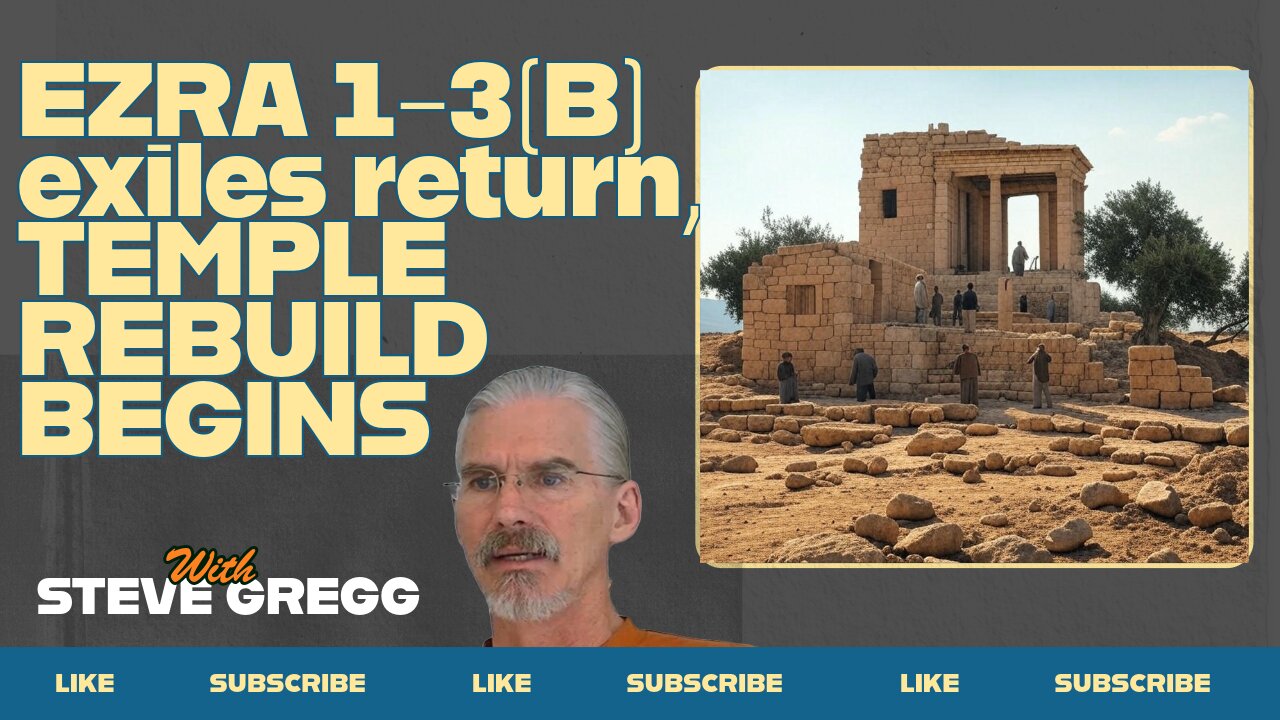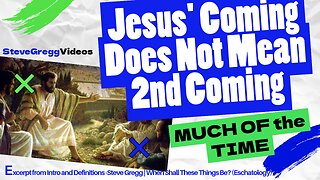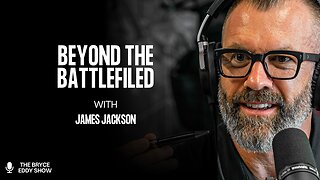Premium Only Content

Ezra 1-3 (Part B) - The Exiles Return, The Temple Rebuild Begins - Steve Gregg
Ezra playlist will be added to here: • Ezra 1-3 (Part A) - Cyrus' Command to... | Ezra Chapter 1: The Decree of Cyrus and the Return
Gregg begins by emphasizing the fulfillment of prophecy in Ezra 1, particularly referencing Jeremiah 25 and 29, where God promised the Babylonian captivity would last 70 years. He highlights the sovereignty of God in moving Cyrus, the Persian king, to issue a decree in 538 BC allowing the Jews to return to Jerusalem and rebuild the temple. Gregg notes that this aligns with Isaiah 44:28–45:1, where Cyrus is named centuries in advance as God’s instrument. He explains that the chapter lists the returnees—led by Zerubbabel—and the temple vessels returned from Nebuchadnezzar’s plunder, underscoring God’s faithfulness to His covenant. Gregg stresses the voluntary nature of the return, pointing out that only a remnant chose to go, reflecting a theme of personal commitment to God’s call.
Ezra Chapter 2: The List of Returnees
In his teaching on chapter 2, Gregg tackles the detailed census of the returning exiles, which includes families, priests, Levites, and others, totaling about 42,360 people, plus servants and singers. He views this list as more than a historical record—it’s a testament to God’s preservation of His people and their identity. Gregg draws attention to the inclusion of those whose genealogies were uncertain (e.g., priests who couldn’t prove their lineage), suggesting it illustrates grace amid strict requirements for temple service. He connects this to the broader theme of restoration, noting that the returnees’ small number compared to the original exile shows both the cost of disobedience and the hope of renewal. Gregg avoids over-spiritualizing the names or numbers but uses them to emphasize God’s care for individuals within the community.
Ezra Chapter 3: Rebuilding the Altar and Temple Foundation
Gregg’s teaching on chapter 3 centers on the first steps of restoration: the rebuilding of the altar and the laying of the temple foundation under Zerubbabel and Jeshua (Joshua) the high priest. He highlights the priority of worship, as the altar is restored even before the temple, enabling sacrifices to resume per the Law of Moses. Gregg ties this to spiritual principles, suggesting that worship and obedience must precede larger acts of rebuilding in the believer’s life. He discusses the mixed emotions at the foundation’s laying—joy from the younger generation and weeping from the older ones who remembered Solomon’s grander temple (Ezra 3:12-13). Gregg interprets this as a realistic portrayal of restoration: progress tempered by the recognition of past glory lost to sin. He also notes the role of opposition hinted at in the chapter’s end, setting the stage for later conflicts.
Key Themes and Application
Across these chapters, Gregg emphasizes God’s providence in orchestrating historical events, the importance of obedience to His commands, and the courage of the remnant to act despite their small numbers and limited resources. He draws parallels to the Christian life, encouraging believers to trust God’s promises, prioritize worship, and persevere through challenges. His teaching avoids speculative tangents, focusing instead on the text’s historical reliability and theological weight.
#ezra #exile #cyrus_the_great #jerusalem #ezra1 #ezra2 #ezra3 #babylon #prophecy #isaiah #daniel #thenarrowpath #stevegregg #70weeksprophecy
-
 15:22
15:22
The Narrow Path
4 days agoJesus' Coming Does Not Mean the "Second Coming" Much of the Time - Steve Gregg
261 -
 33:32
33:32
Ohio State Football and Recruiting at Buckeye Huddle
13 hours agoOhio State Football: What Position is the Biggest Question Mark for the Buckeyes?
19.5K2 -
 LIVE
LIVE
JahBlessGames
1 hour agoEASTER STREAM TEST
75 watching -
 9:30
9:30
VSOGunChannel
18 hours ago $1.48 earnedAdmin Actually Defending the 2nd Amendment?
17.2K10 -
 LIVE
LIVE
Biscotti-B23
3 hours ago $0.15 earned🔴 LIVE REMATCH TOURNAMENT W/ DOTODOYA ⚽ OTSUTSUKI FC VS YOUTUBE ALLSTARS
57 watching -
 44:55
44:55
BEK TV
12 hours agoTARIFFS, TECH TYRANNY, AND PROPHECY: CLAY CLARK EXPOSES THE GLOBAL RESET NO ONE IS TALKING ABOUT
18.5K3 -
 56:09
56:09
TheCommonSenseShow
5 days agoA NEW CONSERVIATIVE MEDIA WILL SOON BE THE LARGEST OUTLET IN THE WORLD
17.5K6 -
 57:50
57:50
Trumpet Daily
2 days ago $4.66 earnedThe Deadly Disease of Forgetting History - Trumpet Daily | Apr. 18, 2025
21.6K4 -
 23:12
23:12
The Bryce Eddy Show
2 days ago $0.75 earnedJames Jackson: Beyond the Battlefield
17.2K3 -
 52:53
52:53
The Escape Zone
3 days ago $0.52 earnedSurvival Security: Learning from the best with bestselling author and former CIA operative!
13.3K